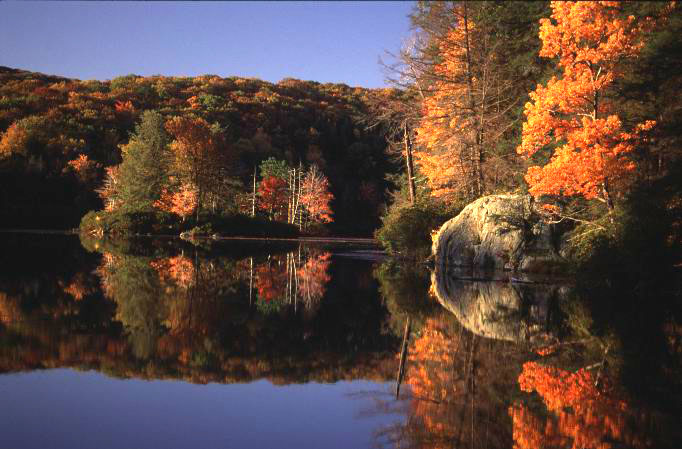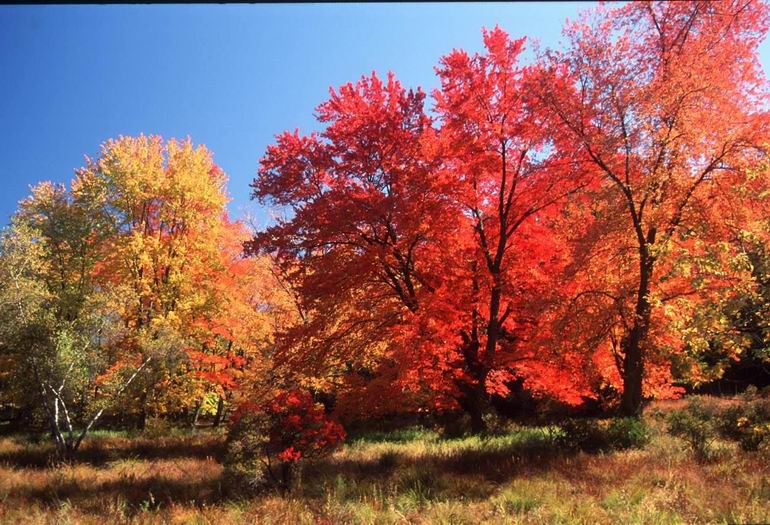
AUTUMN LEAVES
Nature’s Colorful Road Maps
By James H. Moerschel
The cool autumn breeze nipped my face as I sat near a small, gushing waterfall examining
Dozens of colorful leaves through the viewfinder of my camera. The extreme magnification introduced me to intricate patterns, textures and colors, which until this day had eluded my
probing eye.
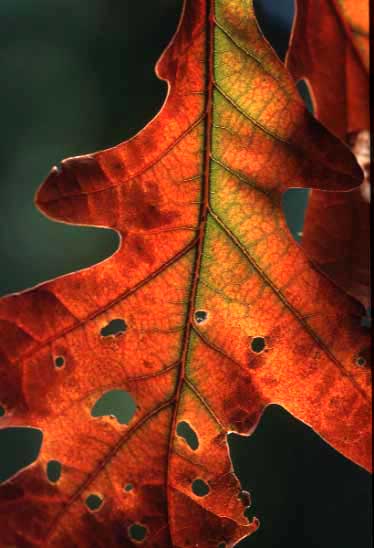
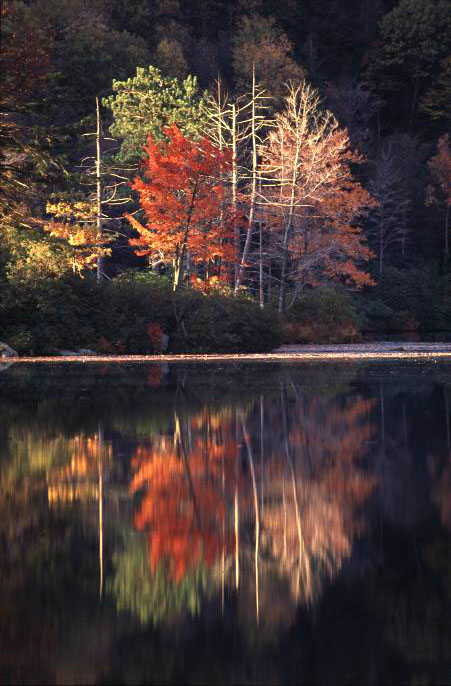
“Just like an artists paint palette daubed with years of accumulated pigments,” I mused.
The kaleidoscopic effect, caused by the blending of brilliant colors and patterns resulted in
a collage of beautiful compositions. Through the lens of a camera, I was viewing a leaf the
way an astronaut views the earth’s surface from a space capsule. The abstract effect created
by the veins, worm eaten sections, colors of red, orange, green and yellow merging together
in brilliant fashion, was taking me on an incredible journey of discovery.
Generally, for me the main attraction of autumn is the spectacle of the changing color
of the leaves. What can be more breathtaking than the view of a valley ablaze with color
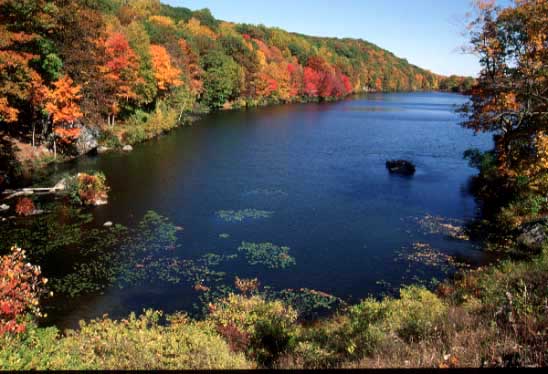
on a bright, clear day? And, as usual, until this day, I have concentrated my viewpoint
on wide-angle panoramic scenes of magnificent trees towering above quaint country homes
and farm buildings. Today’s session would prove to be a revelation. Along with my wide-angle
and telephoto lenses, I carried two macro lenses.
I have learned over the years that while walking under the canopy of a forest when the

brilliant leaves are at their peak can be an overwhelming experience for the photographer.
It can be very difficult to be selective of smaller segments of the over-all scene, which in this
case is so dazzling that it takes great concentration to focus in on smaller, choice sections that
can be effectively translated on film.
I usually arrive at my forest location after daybreak and plan to spend the day. The Photo
experience should not be rushed if it can be avoided, since , like most artistic endeavors, the
creative juices flow better under a relaxed atmosphere. Besides, we should be here to simply
enjoy the nature experience and create photos as an added bonus.

Once I arrive at my general photography site, I find a nice spot to remove my photo backpack
and just sit for awhile. This relaxing interlude allows me to channel my thoughts and energy
toward specific areas of interest. Today, the brilliant leaves are the primary subjects.
Leaves are translucent and allows light to pass through to the viewers eyes. At this time of
the year, leaves radiate with intense color with the type of lighting we photographers call
“back-lighting.” A leaf that is reflecting “front-lighting” is not nearly as dazzling as one that

is transmitting the light through it. So, as I walk the forest trails, my vision is concentrated
in the direction of the sun, which is “backlighting” the over-all scene.
There is a beautiful waterfall that over-looks the Appalachian Trail only two miles from my
home. It has become one of my favorite spots to create photos or just sit and take in the
tranquility of the scene. It was here that I sat and relaxed under the golden canopy of natures
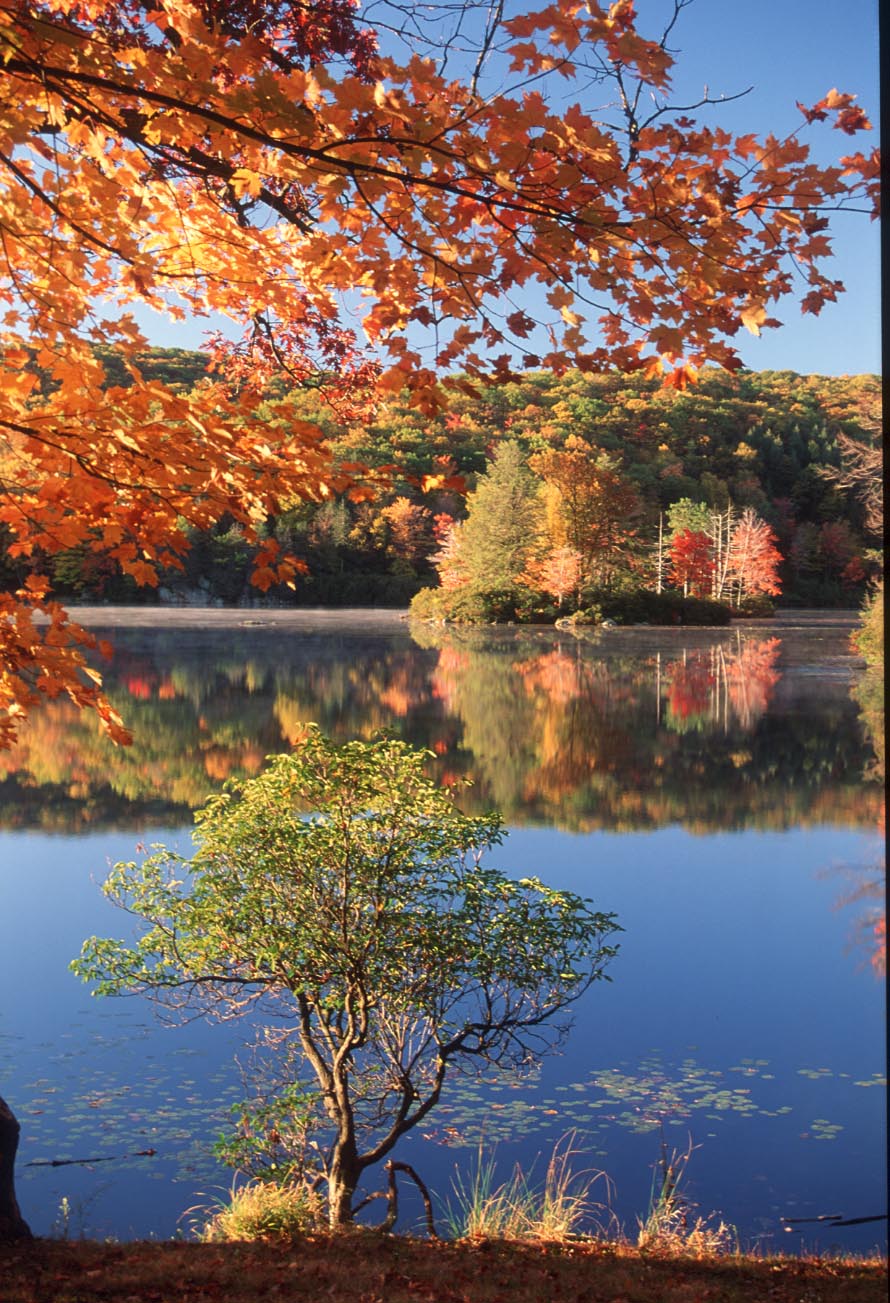
cathedral. With each passing breeze I was showered with multicolored leaves. Casually,
I picked one up and held it to the sun. The brilliant sun intensified the colors and exposed the
fine textures and minute details.
I became aware that several leaves had unusual patterns of holes, blotches of color and a
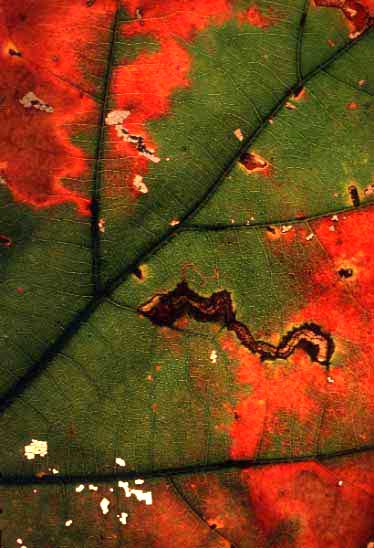

network of veins, displayed on a colorful background. I reached into the depths of my camera
bag , retrieved my 55mm macro lens and began to scan each leaf up close. The brilliant colors
were dazzling, but what intrigued me most of all was the skeletonized sections and colorful
blotches of rust and dark brown patterns. Each leaf was a miniature canvas created by the
millions of tiny inhabitants of the forest and then colored by the ultimate artist herself – Mother
Nature. I knew at that moment that my macro lens was about to launch me on a fascinating new
adventure.
My backyard became the logical place to start my close-up photo sessions. I placed the camera
on my tripod, faced it toward the sun, scooped up a suitable leaf and filled the frame. I made
image after image, rather quickly and with thousands of fallen leaves all around me, I was
standing in a virtual “gold mine.”
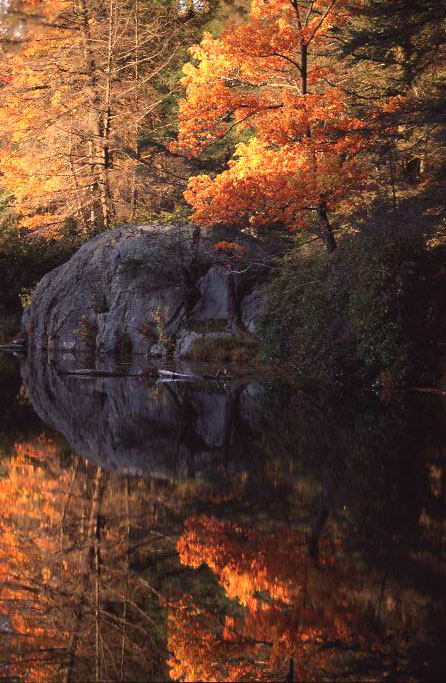
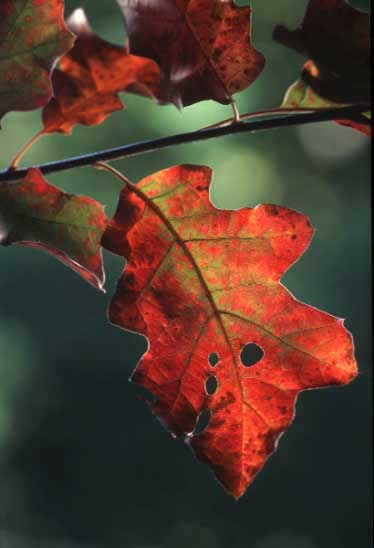
Fortunately, an immature sapling only three feet tall possesses full size leaves the same as a mature
specimen. This makes it easy to move the tripod in close, focus on a desired leaf and make the
photo. I always make it a habit to check the depth-of-field before pressing the shutter. This allows
me to see if everything that I want to be in focus is in focus. If not, I can change the f-stop accordingly.
It is also a good idea to use a cable release to help minimize vibration.
One of the great rewards that the nature photographer reaps from these endeavors is the wealth
of knowledge that can come when reading about the latest subjects. Upon viewing my close-up
leaf images I had many questions that needed answers. New answers produced new questions and
after several weeks of study the world of trees and leaves was becoming very interesting and
added the content for a few articles for magazine publication. The new knowledge spawned new

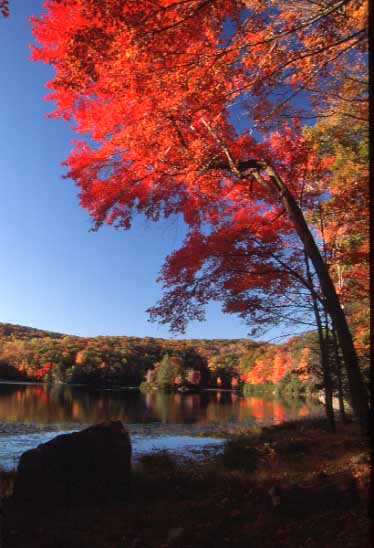
desire to photograph the subject over again, showing some aspect that I had overlooked the first
time. The relationship of photography and knowledge are interwoven so closely that one supports
the other and the photographer becomes the richer for it.
One of the text sources estimated that the average apple tree can have as many as 100,000 leaves.
The mature sugar maple has about 160,000 and a huge oak about 700,000. The billions of leaves
that blanket the forest floor become a protective haven for the equally abundant inhabitants, which
in turn help break down the leaves into humus. The soil of the forest is rejuvenated. Thus, the death
of the leaves in autumn nurtures the rekindling of life in spring.
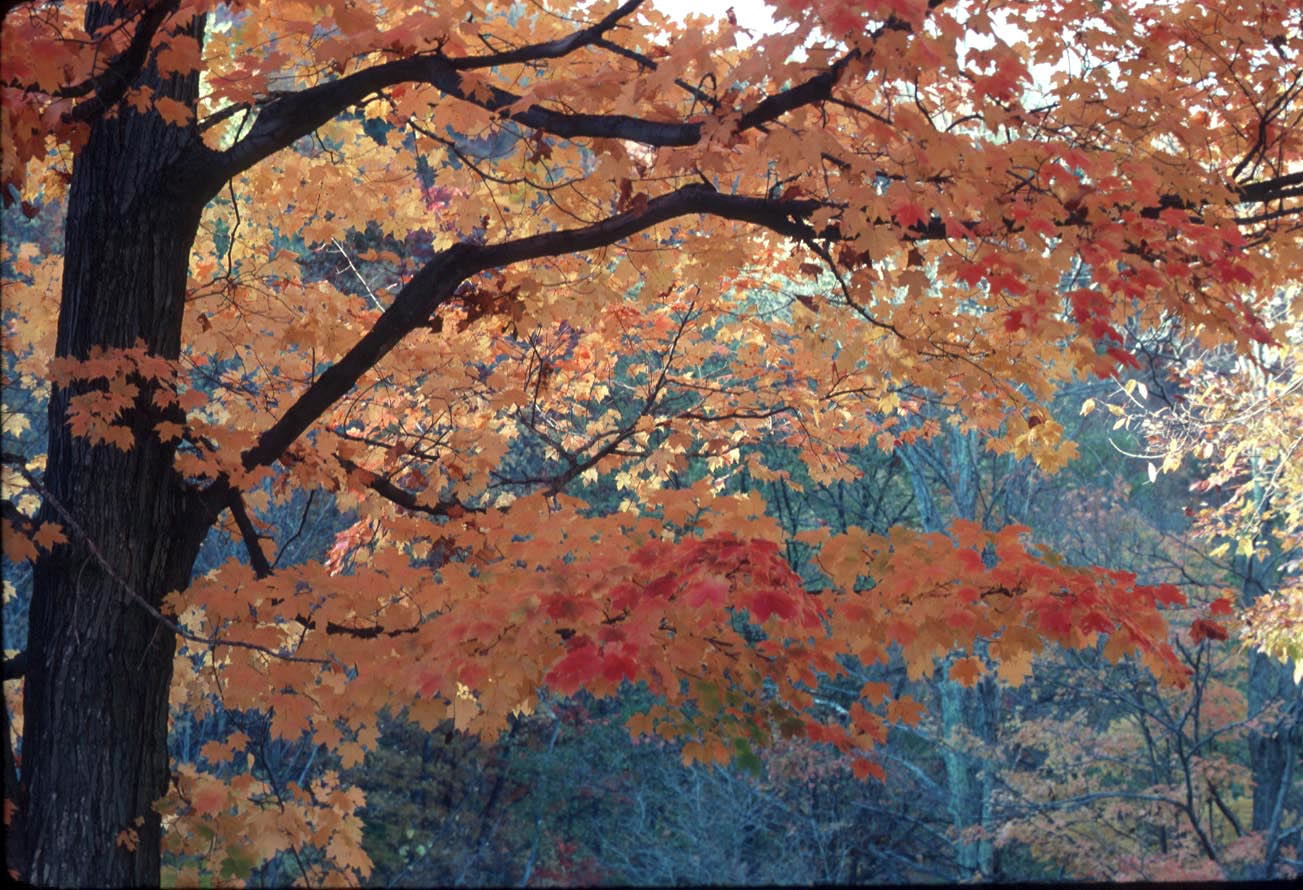
The intricate network of veins on a leaf serves two main functions. It provides the arteries that
carry water to the leaf and food to the rest of the tree. The veins also support the broad skin so that
the leaf is wide enough to receive maximum sunlight. The skin of the leaf has a shiny waxy coat
that prevents evaporation of moisture. It is also transparent to allow the sunlight to reach the interior.
Several of my leaf subjects had various amounts of green areas remaining as the other pigments
began to increase their intensity. The two main photosynthetic tissues of a leaf are made up of tiny
green bodies known as chloroplasts, which contain chlorophyll. As autumn approaches, a complex
internal process shuts down the supply of water throughout the tree, and two thin layers of cells begin
to form at the base of each leaf stem. As these layers grow, they begin to clog the veins of the leaf,
depriving it of both water and nutrients. The green chlorophyll breaks down and quickly disappears,
unmasking the brighter colors of autumn that had been there all along.
Dark brown and rust colored blotches were present on some of the leaf specimens. These leaf
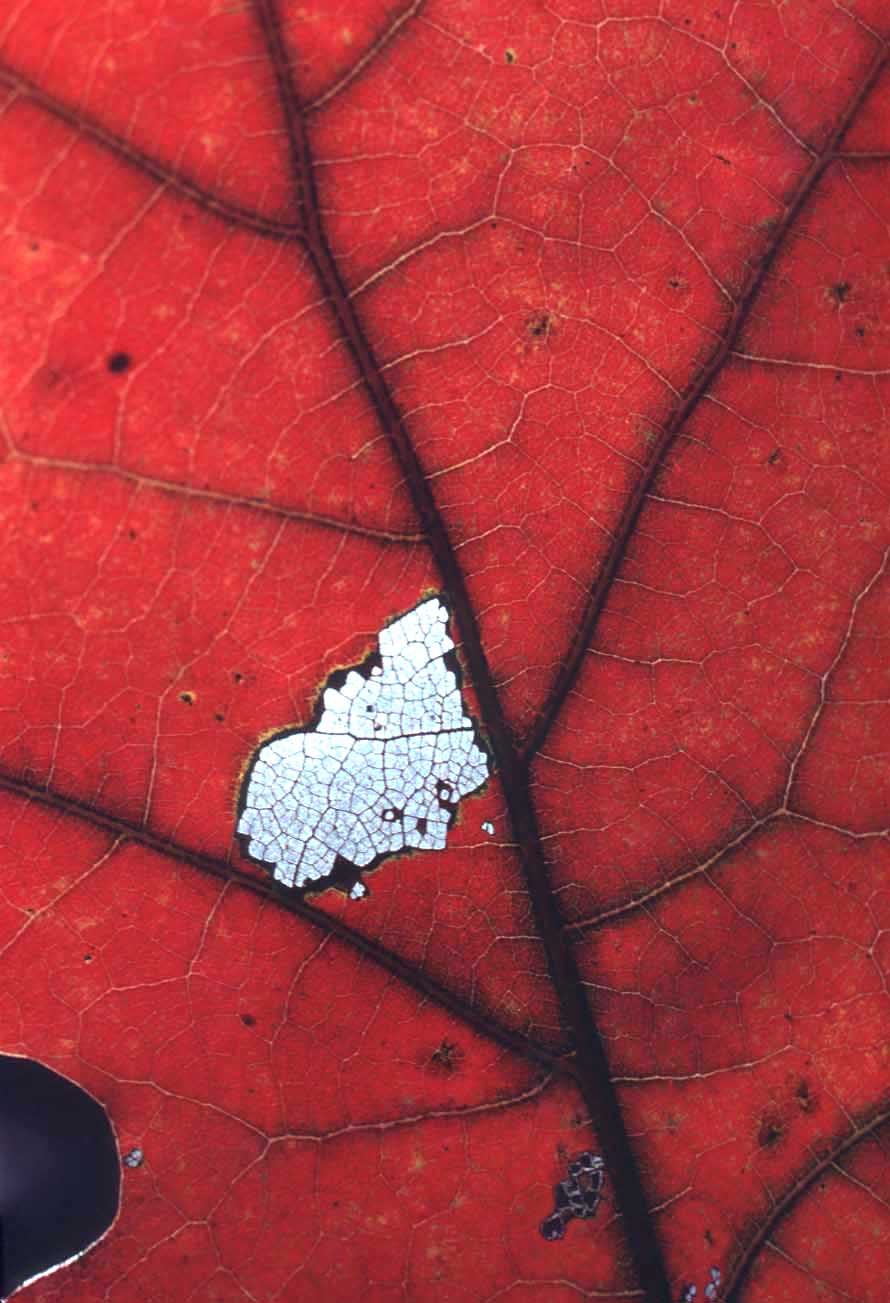
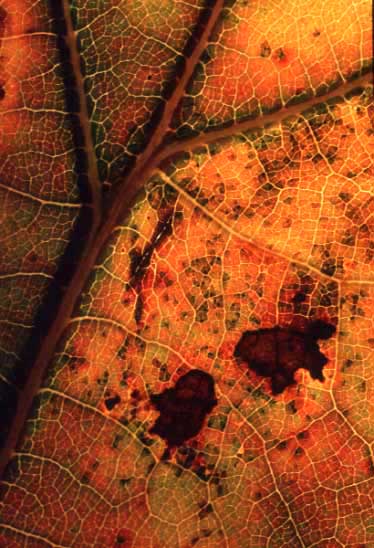
spots are known as mosaics and yellows. Imbalances in water, temperature and minerals cause
many of these blemishes. The rest are caused by viruses, fungi and insects.
Insects cause the skeletonized areas on many of the leaves. Each insect, be it caterpillar, sawfly, or beetle, yields its own characteristic pattern, and it is possible for experts to identify the culprit
by the trail it has left.
Having spent most of the autumn season photographing , studying and writing about leaves,
left little time for seasonal chores. It was time to get to work. With rake in hand I headed
straight for the backyard. My goldmine required an immediate withdrawal. The brilliant reds
and yellows were no longer present and the deep carpet was reduced to a flat, dull brown. The
monotony of the task caused my mind to wander. I glanced up at a huge, regal oak, whose
graceful arms just a few weeks ago had been clad with resplendent finery. Now barren, it awaited

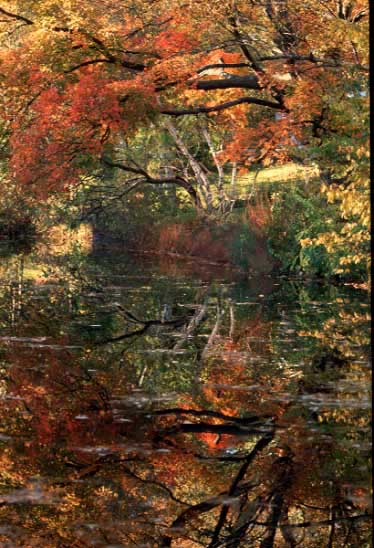
the burdens of ice and snow. Looking at the huge heap covering the yard, I was reminded
of what I read about amounts of leaves on a tree. Were there really only 700,000 leaves on my
towering oak tree? Sure seems like a lot more to me!
